Introduction
The production of Sustainable Aviation Fuel (SAF) is a complex process that involves selecting the right feedstocks and utilizing various production pathways. These pathways, such as Hydroprocessed Esters and Fatty Acids (HEFA), Fischer-Tropsch (FT), Synthesized Iso-Paraffins (SIP), and Alcohol-to-Jet (AtJ), offer unique approaches to converting feedstocks into fuel that can power aircraft sustainably. The aviation industry's commitment to SAF production is driven by the need to reduce carbon emissions and achieve net-zero goals.
Despite the challenges of scaling up production and meeting growing demand, advancements in technology and strategic partnerships are paving the way for increased SAF integration into the aviation fuel supply chain. Moreover, certification and regulatory standards ensure the quality and environmental integrity of SAF. The environmental benefits of SAF, such as significantly reducing carbon intensity and promoting circular economy principles, make it a crucial component in the industry's journey towards sustainability.
However, challenges remain, and future outlooks for SAF production require strategic planning, innovation, and collaboration to overcome obstacles and achieve widespread adoption. The continued development of SAF technologies and the industry's dedication to reducing its carbon footprint demonstrate a promising future for sustainable aviation.
Types of Feedstocks Used in SAF Production
Selecting the right feedstocks is a foundational step in the production of Sustainable Aviation Fuel (SAF). A wide range of feedstocks are available for use, each with its own set of benefits and considerations. From plant-based options such as vegetable oils to waste-derived sources like animal fats and used cooking oils, as well as various forms of biomass, the diversity of feedstocks allows for flexibility in sourcing and sustainability.
The key to optimizing SAF production lies in understanding the unique properties of these feedstocks. For instance, plant oils may be readily available and offer a lower carbon footprint, but factors such as land use and competition with food production can affect their sustainability profile. On the other hand, waste and residue oils, though more challenging to collect and process, provide a high sustainability quotient by repurposing materials that would otherwise go to waste.
Moreover, the technological advancements in SAF production are continually improving the efficiency and reducing the environmental impact of these fuels. Notable achievements in the industry, such as the transatlantic flight powered by a blend of conventional jet fuel and SAF derived from fats and sugars, showcase the potential and progress of these technologies. These milestones not only signify a step towards the industry's goal of net zero carbon emissions but also highlight the need for increased production capacity to meet the growing demand for SAF.
The challenge remains to scale up production to meet less than 0.2 percent of the aviation industry's fuel needs, as evidenced by the recent production statistics in the United States. However, with concerted efforts and strategic partnerships, as seen in the joint venture between Air France-KLM, Delta Air Lines, and Virgin Atlantic, the industry is moving closer to the goal of fully integrating SAF into the aviation fuel supply chain.
Educational initiatives, like the case study conducted by Waubonsee Community College students using the Greenhouse Gases, Regulated Emissions, and Energy Use in Technologies (GREET) model, also play a crucial role. Such programs help foster understanding of Saf's lifecycle impacts and the importance of sustainable fuel sources among the next generation of industry professionals.
In conclusion, SAF represents a significant advancement in the aviation industry's journey towards sustainability. Its production from a variety of feedstocks underscores the need for detailed knowledge of each source's attributes to fully harness their potential, paving the way for a more sustainable future in air travel.
Production Pathways for SAF
Sustainable aviation fuel (SAF) is a critical component in the aviation industry's path to reducing carbon emissions. Each SAF production pathway represents a unique approach to converting various feedstocks into fuel that can power aircraft efficiently and sustainably. For instance, Hydro-processed Esters and Fatty Acids (HEFA) are a well-established pathway, utilizing fats, oils, and greases to produce SAF. On the other hand, innovative methods like alcohol-to-jet (ATJ) pathways are emerging, showing promise for diversifying the feedstock base and enhancing production techniques.
One of the pivotal moments for SAF was when Virgin Atlantic, a leader in airline innovation, marked a major milestone by operating flights aimed at achieving net zero carbon emissions. This endeavor is part of a larger movement within the industry to elevate the role of SAF in meeting environmental goals.
Despite the technological advancements, SAF currently powers only a fraction of flights worldwide. The complexity of scaling up production to meet global demands is a significant challenge. The collaboration between stakeholders—spanning the aviation and energy sectors, as well as the public sector—is essential to foster an environment conducive to SAF expansion. Financial incentives, alongside policy levers, are considered instrumental in incentivizing innovation and increasing SAF supply.
Global approaches to ramping up SAF production vary, with Europe leaning towards mandates, the United States favoring incentives, and Japan using a combination of both strategies. However, the consensus is that incentives are key to encouraging the development of new SAF production technologies.
In summary, the diversity of SAF production methods, from established HEFA to emerging ATJ pathways, highlights the industry's commitment to innovation and sustainability. With airlines like Virgin Atlantic leading by example and the concerted efforts of stakeholders, the scale-up of SAF is poised to play a pivotal role in decarbonizing aviation and contributing to a healthier planet for future generations.
Fischer-Tropsch (FT) Process
The Fischer-Tropsch process stands at the forefront of producing Sustainable Aviation Fuel (SAF), transforming carbon-rich materials into liquid hydrocarbons through a series of sophisticated chemical reactions. Notably, this method generates synthetic fuels of superior quality, compatible with SAF requirements. The process's adaptability to various feedstocks, including biomass and natural gas, underscores its significance in the pursuit of renewable energy sources. As the aviation industry grapples with its carbon footprint—accounting for about 2% of global energy-related CO2 emissions according to the International Energy Agency—SAF presents a practical solution. It serves as a drop-in fuel that can be blended with conventional jet fuel, circumventing the need for new aircraft design or airport infrastructure. This flexibility is crucial given the technical and economic challenges associated with alternative aviation energy sources like batteries and hydrogen.
Innovations in SAF production continue to emerge, with LanzaJet inaugurating the world's first ethanol-to-SAF production plant in Georgia, showcasing a potential pivot towards decarbonized aviation. Further emphasizing the role of SAF, the International Civil Aviation Organization's adoption of a net-zero carbon emissions goal by 2050 places SAF as a pivotal element in achieving this target. Pioneering research, such as that from the University of Wroclaw's BIOTERRAN project, exemplifies the global commitment to developing sustainable energy technologies that harmonize with existing energy infrastructures and support the reliability of energy supply.
With the aviation sector's environmental impact under scrutiny, and as the industry recovers from pandemic-induced setbacks, the integration of SAF into mainstream use is gaining momentum. International agreements, like the one signed in Hamburg for Esaf production, showcase a collective determination to reduce aviation's carbon footprint and secure a sustainable future. The industry's transition towards SAF, albeit gradual with current usage at 0.1% of flights, is a testament to the sector's acknowledgment of the urgency to adopt cleaner fuels and the innovative strides being made in SAF production and policy.
Hydrotreated Esters and Fatty Acids (HEFA) Process
The Hydroprocessed Esters and Fatty Acids (HEFA) method represents a significant stride forward in the production of Sustainable Aviation Fuel (SAF). By hydrotreating feedstock such as vegetable oils or animal fats, the HEFA process strips away contaminants, transforming these materials into hydrocarbons that are nearly identical to those found in conventional jet fuel. The resulting SAF can be seamlessly integrated with current aviation infrastructure, providing a 'drop-in' solution that does not require modifications to aircraft engines or fuel distribution systems. This process is not just a theoretical concept; it's actively contributing to the decarbonization of industries. For instance, in the pursuit of a zero-impact carbon footprint, companies such as Heineken Spain and Fertiberia have pioneered the use of green hydrogen—produced from renewable electricity—to replace natural gas, thereby slashing emissions from industrial processes.
Innovative projects like these highlight the practical applications of green hydrogen and its derivatives, demonstrating their efficacy in real-world scenarios beyond laboratory settings. The aviation sector is poised to benefit tremendously from this technology, as illustrated by recent milestones, such as Virgin Atlantic's recognition as a Five Star Airline and Germany's commitment to establishing eSAF production capacities, underlining the industry's dedication to achieving net zero carbon emissions. Saf's potential is also underscored by the GOLIAT project, which is at the vanguard of integrating hydrogen into the aviation fuel mix at airports—a nod towards the future of decarbonized air travel.
However, scaling SAF production to meet the burgeoning demand of the aviation industry remains a challenge. Presently, a mere 0.1% of flights utilize SAF, and with the US aviation sector being the third largest source of national transportation emissions, the urgency to expand SAF usage is more pronounced than ever. The industry recognizes that while modern aircraft are more fuel-efficient, the rate of fleet expansion necessitates additional, substantial measures. SAF emerges as the most feasible mid-century solution for decarbonization, especially considering the longevity of commercial aircraft and the limitations in electrifying long-haul flights. British firms are exploring diverse pathways for SAF production, including the conversion of human waste into fuel, highlighting the innovative and limitless potential of SAF to meet future demands while adhering to environmental sustainability.
Synthesized Iso-Paraffins (SIP) Process
Sustainable Aviation Fuel (SAF) production technologies like the SIP process are vital in the aviation industry's quest for sustainability. This specific pathway harnesses hydrogenation and ISOmerization to transform biomass or other renewable feedstocks into ISO-paraffins. Once produced, these ISO-paraffins can be refined into SAF, which boasts a high energy density that is fully compatible with current aircraft engines. Such innovations are crucial as the industry progresses towards carbon-neutral goals, as evidenced by Virgin Atlantic's historic flight fully powered by 100% SAF, marking a significant advancement towards net-zero carbon emissions. Sir Richard Branson, the airline's founder, emphasized the importance of innovation in pushing the industry forward, reflecting on Virgin Atlantic's commitment to sustainable practices since its inception. This commitment is underlined by the opening of LanzaJet's Freedom Pines Fuels facility, the first in the world to convert ethanol to SAF, illustrating the potential for technology to revolutionize aviation and reduce its environmental impact. With commercial aviation prioritizing safety and efficiency, these developments in SAF production are not only environmentally imperative but also align with the industry's core values.
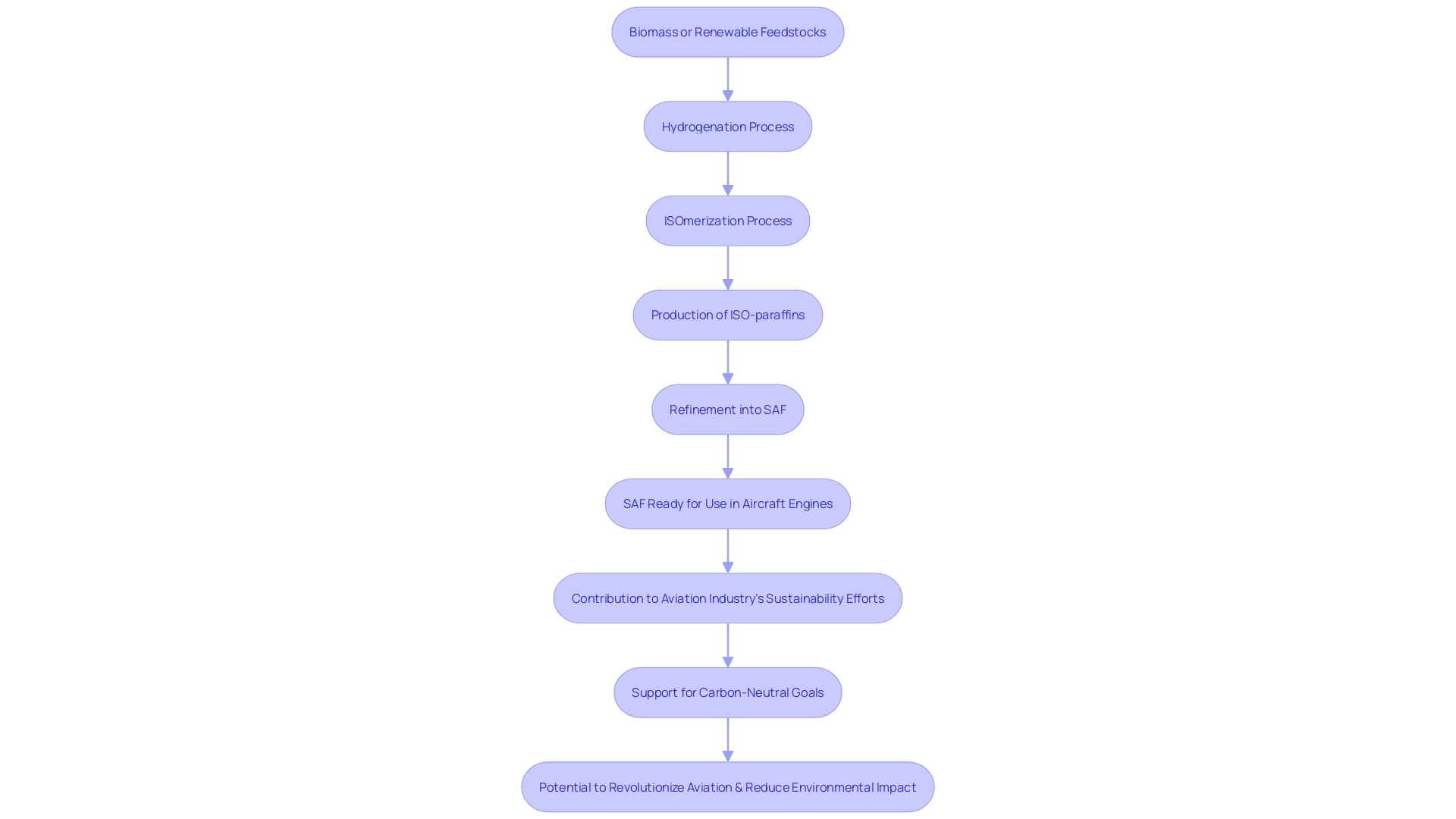
Alcohol to Jet (AtJ) Process
Sustainable Aviation Fuel (SAF) production is a critical component in the aviation sector's quest to reduce its environmental footprint. The Alcohol-to-Jet (AtJ) pathway is one such promising technology that converts alcohols like ethanol into jet fuel. The process starts with the dehydration of ethanol, followed by a series of catalytic reactions that ultimately yield synthetic paraffinic kerosene, a type of SAF. This innovative approach leverages existing bioethanol resources and could significantly cut down carbon emissions associated with aviation.
A case study conducted with students from Waubonsee Community College, using the GREET model developed at Argonne National Laboratory, highlights the life-cycle benefits of Safe. The robust educational material allowed students from diverse disciplines to explore the environmental implications of SAFs, emphasizing the interdisciplinary appeal of this subject.
The urgency of this innovation is underscored by the International Energy Agency's finding that aviation contributes about 2% of global energy-related CO2 emissions. The challenges of electrifying aircraft due to technical and infrastructural barriers make SAF a more immediate solution. With industry support from organizations like the International Air Transport Association and commitments from airlines such as Delta and Air France for a 10% SAF use by 2030, the adoption of SAF is gaining momentum.
LanzaJet's Freedom Pines Fuels facility in Soperton, Georgia, exemplifies the scale-up of SAF production. This plant is set to reduce greenhouse gas emissions by over 70% compared to conventional jet fuel. The technology used at this facility is poised to create new jobs and generate considerable economic activity locally, with a commitment to supply SAF for the next decade.
Meanwhile, a collaboration between the Whiting School, the University of Alabama, and Oak Ridge National Laboratory is propelling the industry forward with a plant-based jet fuel project. With a $2.5 million grant from the Department of Energy, this team is working on converting ethanol into butene and then into jet fuel, further supporting the notion that SAF can help offset CO2 emissions.
With emissions from the US aviation sector accounting for approximately 7% of the nation's transportation emissions and expected to rise, the need for sustainable solutions like SAF is becoming increasingly critical. The commercial readiness of AtJ technology and the support from educational institutions, government agencies, and the private sector signal a transformative period in aviation fuel production, aligning with the sector's net-zero aspirations by 2050.
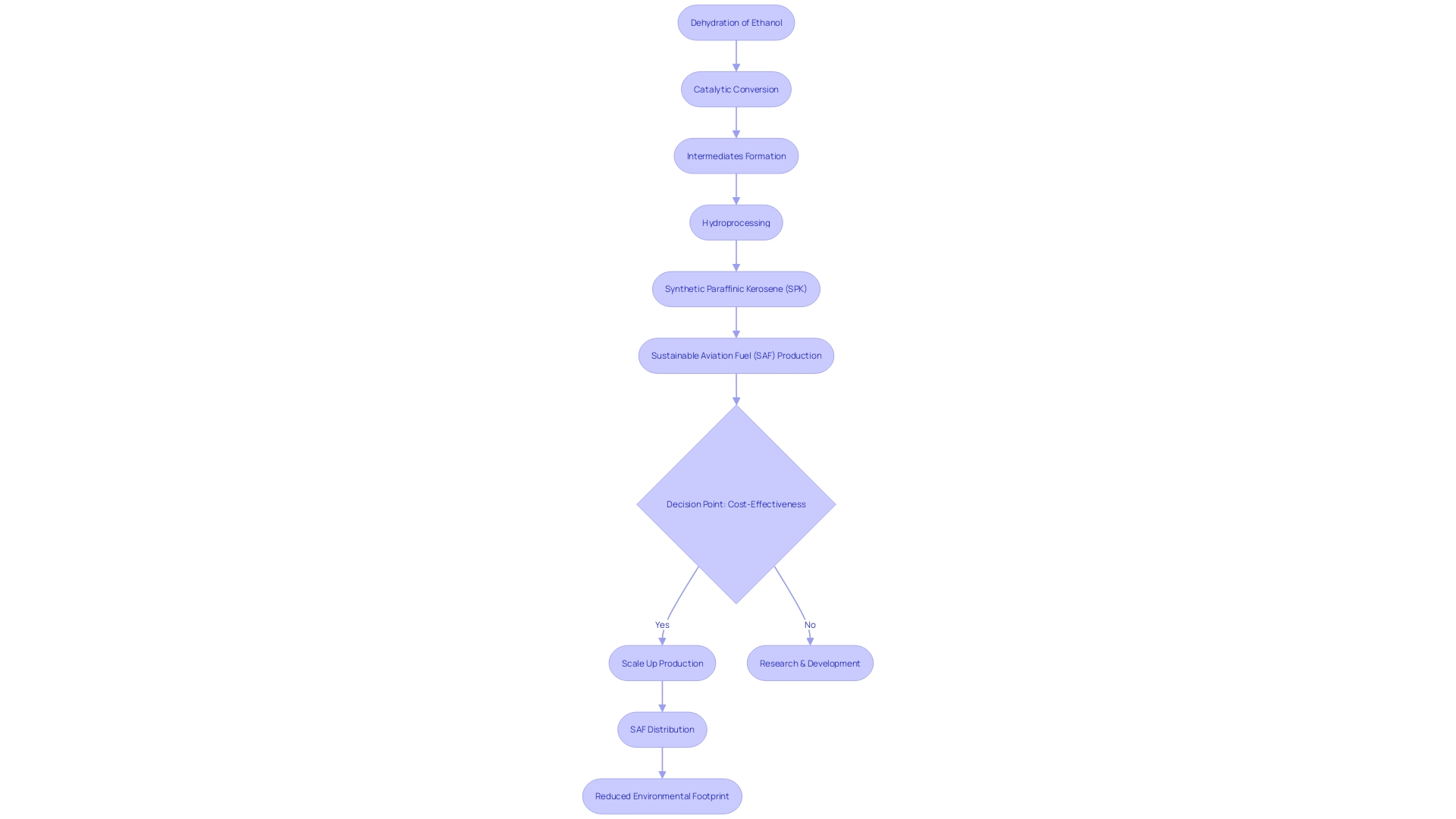
Feedstock Collection and Pre-treatment
The initial phase in sustainable aviation fuel (SAF) production is a critical juncture where feedstocks are gathered, stored, and pre-treated to meet stringent quality standards. Industry experts like Brian, with a rich background in forestry procurement and supply chain operations, understand the complexity of sourcing biomass feedstock sustainably and efficiently. Their experience in managing multiple manufacturing plants showcases the necessity of robust collection methods that align with environmental and economic goals. As highlighted by recent investments in renewable energy, with billions of dollars flowing into the sector, the importance of a well-organized feedstock supply chain cannot be overstressed. Pre-treatment processes, including advanced filtration and refining techniques, are fundamental in ensuring the feedstock's purity, directly impacting the overall performance and environmental footprint of the final SAF product. These initial steps are integral to the energy transition, as underscored by the considerable advancements in renewable energy policy and the development of over 8GW of renewable power projects by veterans like Ric. The expertise of professionals like Alyssa in large-scale energy projects emphasizes strategic stakeholder engagement, which is essential for the deployment of effective pre-treatment technologies. Their work supports the drive towards a net-zero future, resonating with BP's net-zero ambition and the global push towards cleaner shipping methods. In conclusion, the meticulous preparation of feedstock is a testament to the industry's commitment to sustainability and innovation, setting the tone for the subsequent stages of SAF production.
Chemical Reactions and Processing Steps
The transformation of raw feedstocks into Sustainable Aviation Fuel (SAF) is a sophisticated process that involves a plethora of meticulously controlled chemical reactions and processing stages. Each production pathway is distinct, utilizing specific catalysts and operating under conditions tailored to optimize yield and efficiency. Let's unwrap the intricate web of processes that turn organic matter into a fuel that is revolutionizing the aviation industry.
SAF production pathways are diverse, but they share a common goal: to produce a clean-burning fuel that can satisfy the energy demands of commercial flight while minimizing environmental impact. For instance, a pioneering flight, recently powered entirely by SAF, marked a significant leap towards the aviation sector's goal of net-zero carbon emissions. This flight's success story underscores the vital role that SAF will play in the future of air travel.
To understand the SAF production process, we must consider the insights offered by industry leaders with decades of experience in energy and environmental sectors. Such expertise is exemplified by professionals like Ric, with over 40 years in the energy field, and Brian, whose background in forestry and procurement for manufacturing plants like Enviva, provides a unique perspective on sourcing and managing the biomass feedstocks critical to SAF production.
The conversion process itself requires a nuanced understanding of the interaction between catalysts and feedstocks. Whether it's utilizing fats, sugars, or even municipal waste, the transformation into SAF hinges upon the right chemical environments and reaction parameters. These catalyst-driven reactions are not just theoretical concepts but are being applied in real-world scenarios to meet the demands of airlines committed to reducing their carbon footprint.
The industry's move towards SAF is propelled by more than just environmental incentives; there is a clear business case for the transition. With airlines like Virgin Atlantic making strides in incorporating SAF into their operations, the economic landscape of aviation fuel is poised to shift dramatically. The commitment to SAF by these airlines, alongside regulatory encouragement, is creating a robust market for these greener fuels.
In conclusion, the meticulous chemical engineering behind SAF production is as critical as the strategic decisions made by industry leaders committed to sustainable practices. Together, they are steering the aviation industry towards a future where flights are powered not by fossil fuels, but by innovative, sustainable alternatives that align with global decarbonization goals.
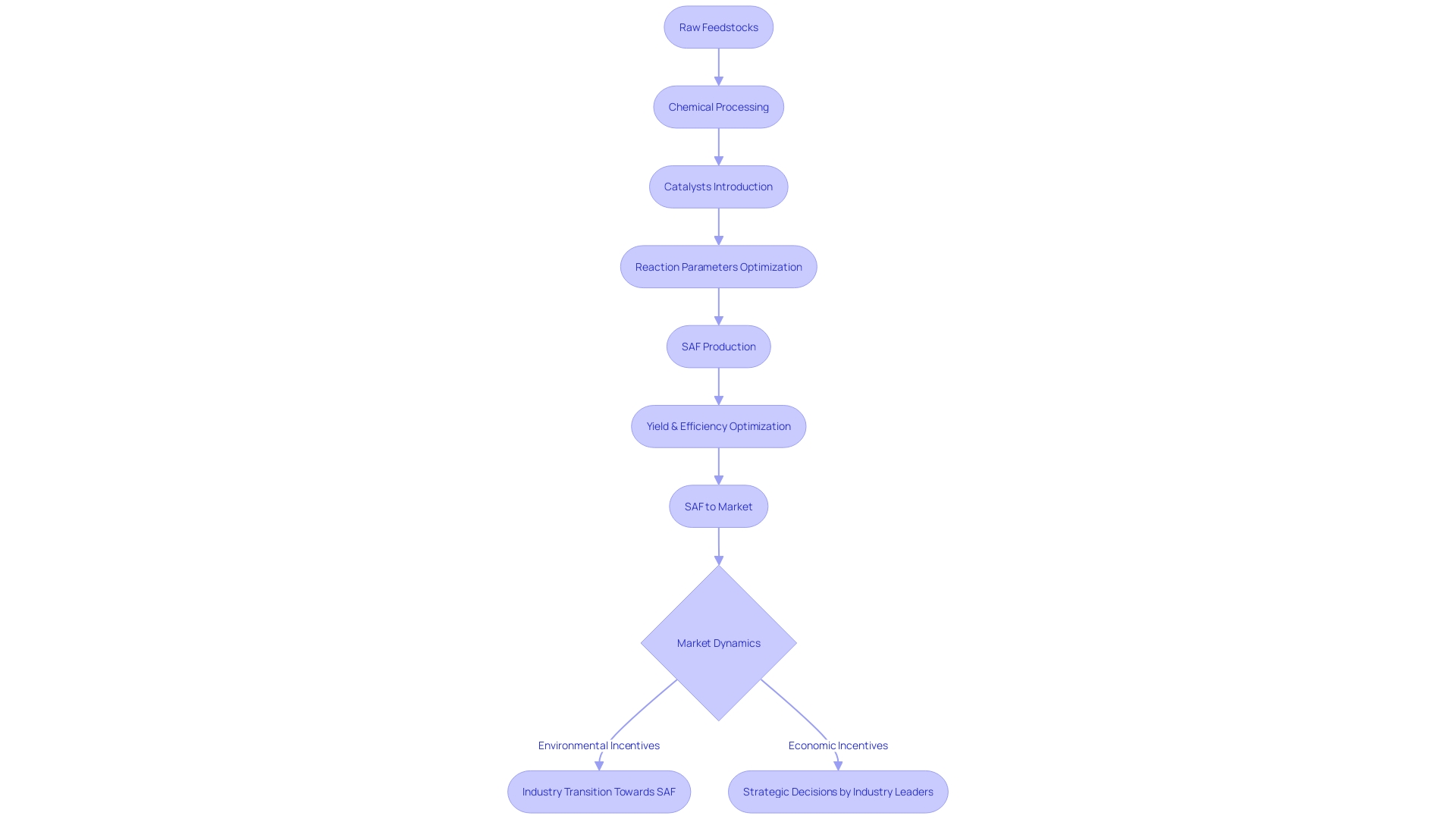
Blending SAF with Conventional Fuel
Integrating Sustainable Aviation Fuel (SAF) with traditional jet fuel is a pivotal strategy in the aviation industry's pursuit of reduced carbon emissions. The process involves meticulous considerations to ascertain the most effective blend ratios and ensure compatibility with existing aircraft engines. Presently, airlines like Virgin Atlantic are leading the way by incorporating SAF on transatlantic flights, signifying a significant step towards the industry's goal of achieving net-zero carbon emissions by 2050.
Blending SAF with conventional jet fuel not only aligns with the International Civil Aviation Organization's (ICAO) vision but also supports the global commitment to mitigate climate change impacts. While the use of SAF is currently limited, with only 0.1% of flights utilizing it, advancements in production and technology are expected to enhance its feasibility and adoption rate. SAF is compatible with existing aircraft without requiring modifications, and it offers a pathway to substantial CO2 reduction, as the lifecycle emissions can be up to 80% lower compared to traditional jet fuels.
The journey to scale up SAF production and use is complex, involving technological innovation, regulatory frameworks, and collaborative efforts across the aviation sector. Virgin Atlantic's expansion of routes, alongside its partners in the Joint Venture, demonstrates the airline's dedication to innovation and customer service while emphasizing the importance of sustainability in its operations. As the aviation industry continues to grow, with forecasts indicating a rise in air travel and freight transport, the integration and optimization of SAF blend ratios will play a crucial role in the decarbonization efforts, offering a practical solution in the interim as the sector explores and develops longer-term alternatives such as hydrogen or electric-powered aircraft.
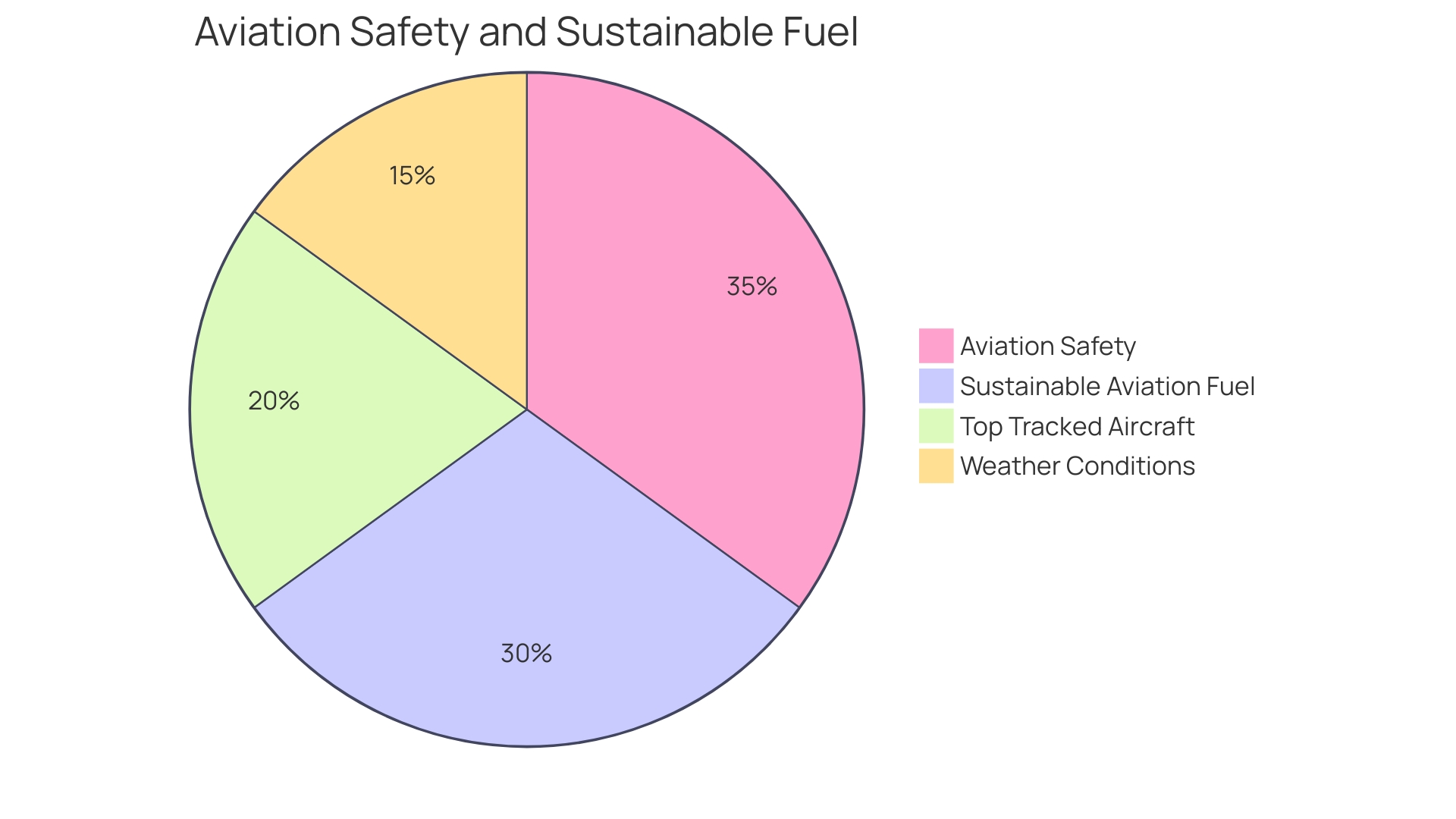
Certification and Regulatory Standards
Sustainable Aviation Fuel (SAF) production is bound by rigorous certification and regulatory frameworks to ensure its quality and environmental integrity. These frameworks are crucial for the aviation industry's transition towards more sustainable practices. For instance, the European Union has taken a proactive stance by working with the International Civil Aviation Organization (ICAO) to establish a global framework for SAF. This includes an ambitious goal to reduce CO2 emissions by 5% by 2030 through the increased use of SAF, with a review planned for 2028 to adjust to market and production capacity developments. The EU's 'Fit for 55' package, part of the ReFuelEU Aviation initiative, further underscores this commitment, aiming to reduce net greenhouse gas emissions by 55% by 2030 and achieve climate neutrality by 2050.
The United States, acknowledging that the aviation sector accounts for approximately 7% of the nation's transportation emissions, also recognizes the imperative of scaling SAF to decarbonize the industry. With the longevity of commercial aircraft, which operate for an average of 20 to 30 years, reliance on improvements in aircraft design alone is not sufficient. The U.S. must foster cooperation among stakeholders in the aviation and energy industries, as well as the public sector, to expedite the adoption of SAF.
In the Middle East, similar collaborations and policy levers are being identified to create a nurturing environment for SAF growth, reflecting a global understanding of the necessity for such fuels. However, despite these efforts and the establishment of safety and sustainability standards, SAF currently powers only a minimal fraction of flights—0.1%. This highlights the need for continued investment and development in this area to meet the burgeoning demand for air travel and air freight transport without exacerbating environmental impact.
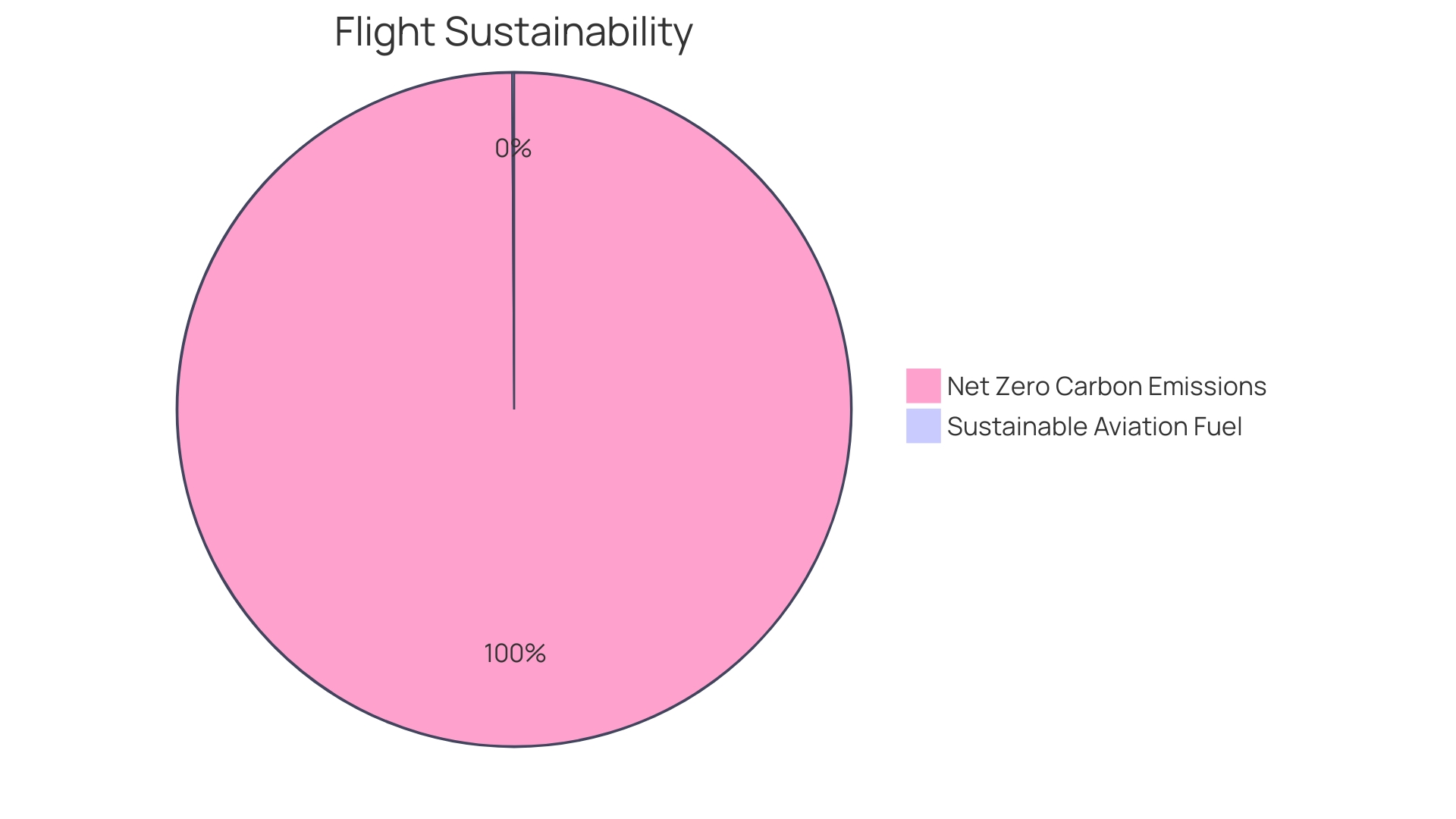
Environmental Benefits and Carbon Reduction
Sustainable Aviation Fuel (SAF) stands at the forefront of the aviation industry's efforts to achieve net-zero carbon emissions by 2050. With the aviation sector accounting for approximately 3.5 percent of anthropogenic climate impacts, the transition to SAF is not just innovative but essential. Studies suggest that SAF can reduce carbon intensity of flying by over 80 percent, a substantial improvement over traditional fossil fuels.
Although SAF is still a nascent technology—representing less than 0.1 percent of global aviation fuel—its potential is demonstrated by industry leaders like Delta Air Lines, which aims to replace 10% of its jet fuel with SAF by 2030. Delta is also striving to cut its overall fuel usage year over year, signifying a dual approach to sustainability.
The production of SAF from renewable waste materials like used cooking oils and animal fats is an example of circular economy in action. This not only diverts waste from landfills but also provides a renewable energy source that can seamlessly integrate with existing engines and infrastructure, negating the need for new designs or systems.
Moreover, the non-CO2 impacts of aviation, such as the formation of contrail cirrus clouds, are gaining recognition for their climate effects. Saf's role in mitigating these impacts is an area of ongoing research, which could lead to further environmental benefits.
Education and awareness are critical in advancing the adoption of SAF. As consumers become more informed about the environmental advantages of SAF, including its potential to improve air quality near airports and contribute to overall climate change mitigation, demand is likely to grow.
The industry's commitment to SAF is exemplified by Virgin Atlantic's continuous innovation and customer-focused service, which has earned it the accolade of Britain’s only Global Five Star Airline by APEX. This commitment extends to partnerships, like the expanded Joint Venture with Air France-KLM and Delta Air Lines, which aims to enhance sustainable travel options.
In the realm of SAF technology, LanzaJet's groundbreaking Freedom Pines Fuels plant in Soperton, Georgia, marks a historic step. As the world's first ethanol-to-SAF production facility, it showcases the practical application of advanced technology in the pursuit of decarbonized aviation. The plant embodies the journey toward a more sustainable travel experience and the power of innovation to make what once seemed impossible, possible.
Challenges and Future Outlook for SAF Production
Sustainable Aviation Fuel (SAF) is an innovative solution that offers the potential to significantly reduce the environmental impact of the aviation industry. However, the path to widespread SAF adoption is not without hurdles. The production process must contend with the challenges of securing adequate and cost-effective feedstock, a critical step in creating the clean raw material necessary for SAF. As the industry seeks to scale up production to meet the demand for greener fuel alternatives, strategic planning is essential to ensure the efficient grouping of processing facilities near feedstock sources, thus minimizing transportation and infrastructure costs.
Advancements in SAF technology and supportive policies are key to overcoming these obstacles. For instance, the integration of modern automation and assembly technologies can streamline SAF production, mirroring the success seen in high-end manufacturing sectors. Such innovation, coupled with a culture that prioritizes technological leadership, can propel the SAF industry forward.
The environmental benefits of SAF were recently underscored by a landmark flight, signaling a major advancement in the aviation sector's journey towards net-zero carbon emissions. This milestone emphasizes the importance of continued investment and development in SAF technologies.
Despite the challenges, the future prospects for SAF remain promising. By fostering a holistic understanding of sustainable fuel lifecycles and by leveraging new developments, the aviation industry can make significant strides towards reducing its carbon footprint. With only 0.1% of flights currently powered by SAF, there is a vast opportunity for growth, especially considering the aviation sector's contribution to transportation emissions and the longevity of commercial aircraft in operation. The transition to SAF is not merely a technical challenge but also a complex logistical endeavor that requires collaboration across the industry to achieve the ultimate goal of decarbonizing aviation.
Conclusion
The production of Sustainable Aviation Fuel (SAF) involves selecting the right feedstocks and utilizing various production pathways. Technological advancements, such as Hydroprocessed Esters and Fatty Acids (HEFA) and Fischer-Tropsch (FT) processes, show promise in reducing carbon emissions and achieving net-zero goals. Despite challenges in scaling up production, strategic partnerships and advancements in technology are paving the way for increased SAF integration into the aviation fuel supply chain.
Certification and regulatory standards ensure the quality and environmental integrity of SAF. Its environmental benefits, including reduced carbon intensity and support for circular economy principles, make it crucial for the industry's journey towards sustainability. Challenges remain, but with strategic planning, innovation, and collaboration, SAF production can overcome obstacles and achieve widespread adoption.
In conclusion, the production of Sustainable Aviation Fuel represents a significant advancement in the aviation industry's sustainability journey. The industry's dedication to reducing its carbon footprint, along with ongoing SAF technology development, demonstrates a promising future. By integrating SAF into the aviation fuel supply chain, the industry can achieve net-zero goals and contribute to a more sustainable future for air travel.




